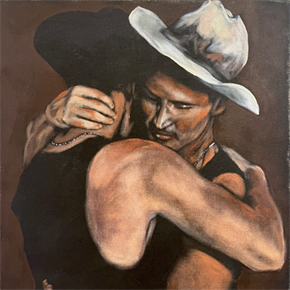DALLAS, Texas — The tiny greenbug aphids clinging to my outfit matched the logo of the Dallas Art Fair (DAF) — a clean, verdant, lime-green square. The air was thick and warm, but it’s early enough in the season that the croaky birds known as grackles have yet to get loud, giving the bustle around the concrete mid-century Fashion Industry Gallery building an aura of spring awakening, with art as colorful as the outfits filing in and out the swinging glass doors in the city’s downtown.
For eight of its 16 years, the Dallas Art Fair Foundation and Dallas Museum of Art Acquisition Fund has raised significant funding to facilitate acquisitions from the show for the institution’s permanent collection. “Fairs are about that moment in time when everyone can be in the same room,” Kelly Cornell, the fair’s director, told Hyperallergic. But the fair hasn’t been without challenges: In 2020, after the fair was canceled due to pandemic restrictions, 30 gallerists attempted to get their booth payments back and were met with resistance.
It’s said you can’t rush a Dallas collector through a sale, and it’s the Southern style to wait for the preview to pass before closing. Even so, I eavesdropped on a few soft deals while wandering through the enormous space. In fact, I heard plenty — from well-heeled women discussing where they bought their spring season pieds-a-terre to jokes about the eclipse — amid a surprising lack of cowboy hats (although around here, it’s impolite to wear your hat indoors).
Thinking they were leftover dishes, a catering staff member drifted into Alexander Berggruen’s booth and attempted to clean up Stephanie H. Shih’s sculptures, consisting of a porcelain 7-Eleven bag paired with a glassy pouch of Funyuns chips. She stopped in her tracks and retreated while the gallery staff was distracted by a collector.
Paintings, of course, were the overwhelming majority of artwork at DAF, and according to a young gallerist, landscape paintings in particular are selling like hotcakes. Abstraction in dense compositions and vivid color palettes dominated the booths with sprawling depictions of the natural world, with Western aesthetics and cowboys coming in a close second.
Hands down, Wolfgang Gallery in Atlanta, Georgia, only a year into its programming, brought one of the standout painters of the entire fair. Alic Broc’s canvases are feats of assemblage, airbrushed, close-cut perspectives of rust-belt cowboys in tight Wranglers and leather boots, crouching in grass or on Spanish tile. In “Neither-This-Nor-That” (2024), one such figure clutches a rose in memory of his mother.
The work of Maureen O’Leary, presented by New York’s Cristin Tierney Gallery, was another standout. The artist’s use of color to depict scenes from Rome and busy, bursting tablescapes, along with flat tilted perspective, reminded me of Wayne Thiebaud’s underrated city paintings. “Looking Glass” (2024) by Sean Cairns at the booth of the Dallas- and Los Angeles-based gallery 12.26 depicts a sprawling mountain valley in oil and enamel, with glittering distemper and sand to affect a rougher surface.
Meanwhile, McClain Gallery in Houston couldn’t keep the bright, brooding volcano paintings of Brazilian-born, Bozeman-based painter Bruna Massadas on its wall.
“Sonny Boi Summer” (2023), a wall weaving by sixth generation Diné weaver Tyrrell Tapaha, represented by The Valley in Taos, New Mexico, combines Tapaha’s ancestral “sheep to loom” family practice using handspun and vegetal dyed Navajo Churro wool, alpaca, and mohair. Amid chevron stripes and traditional whirling logs is the phrase: “All that for a boy?”


